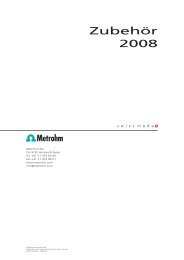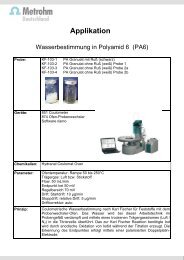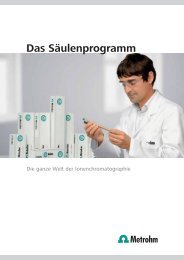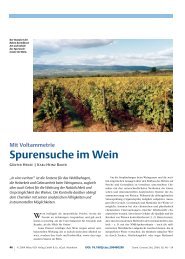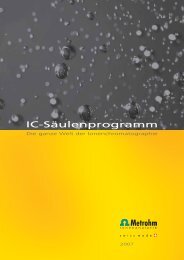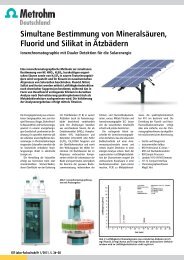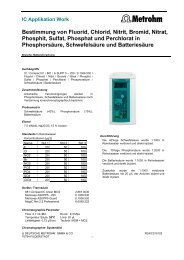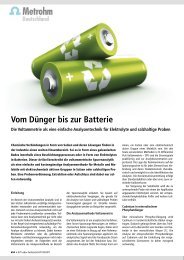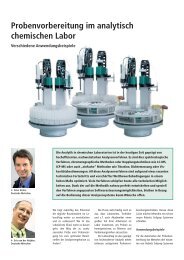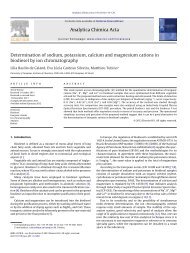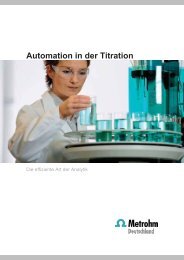Metrohm Autolab
Metrohm Autolab
Metrohm Autolab
Create successful ePaper yourself
Turn your PDF publications into a flip-book with our unique Google optimized e-Paper software.
<strong>Metrohm</strong> <strong>Autolab</strong><br />
Instruments for electrochemical research
02<br />
02<br />
<strong>Metrohm</strong> <strong>Autolab</strong><br />
• Founded in 1986<br />
• Based in Utrecht, The Netherlands<br />
• Since 1999 part of the <strong>Metrohm</strong> Group<br />
• Introduced the first computer controlled potentiostat/galvanostat<br />
• Develops and produces the high quality <strong>Autolab</strong> range of products<br />
• Strong background in electrochemistry<br />
• Supported by the worldwide <strong>Metrohm</strong> distribution network<br />
• Three years factory warranty on all instruments<br />
• Dedicated to research
International presence<br />
Eco Chemie – <strong>Metrohm</strong> <strong>Autolab</strong><br />
Eco Chemie was founded in 1986 and is since 1999 a<br />
member of the <strong>Metrohm</strong> group of companies. In 2009<br />
the company name changed to <strong>Metrohm</strong> <strong>Autolab</strong> to<br />
reflect the customer oriented combination of the worldwide<br />
<strong>Metrohm</strong> sales and support organization and the<br />
high quality <strong>Autolab</strong> series of instruments developed by<br />
Eco Chemie.<br />
<strong>Metrohm</strong> <strong>Autolab</strong> is an ISO9001 certified company.<br />
<strong>Metrohm</strong> <strong>Autolab</strong> based in Utrecht, The Netherlands,<br />
designs and manufactures <strong>Autolab</strong> instruments, accessories,<br />
and software for electrochemistry.<br />
Known for innovation, the <strong>Autolab</strong> was the first commercial<br />
digital potentiostat/galvanostat, that was completely<br />
computer controlled. Our latest software package NOVA<br />
has again set a high standard for powerful electrochemical<br />
research software.<br />
With our background and knowledge in electrochemistry<br />
and our worldwide distributor network, our mission is<br />
to serve the research community all over the world by<br />
supplying state of the art instruments and unrivalled<br />
support. All <strong>Metrohm</strong> <strong>Autolab</strong> instruments are covered<br />
by a three year factory warranty.<br />
03
04<br />
The <strong>Autolab</strong> N series<br />
The N series are state of the art, high end modular<br />
Poten tiostat/Galvanostat instruments. Each device in this<br />
product range benefits from over two decades of experience<br />
in design and production.<br />
Regardless of the field of application, the instruments in<br />
the N series are designed to address any electrochemical<br />
measurement. The modular concept provides the means<br />
for the instrument to grow with your needs of today and<br />
tomorrow.<br />
<strong>Autolab</strong> instruments are known worldwide for their very<br />
high quality and reliability. <strong>Metrohm</strong> <strong>Autolab</strong> only uses<br />
the best and most robust components in the design of<br />
their products, which in turn makes the instruments in<br />
the N series the ideal choice for your research.<br />
PGSTAT128N 12 V / 800 mA<br />
PGSTAT302N 30 V / 2000 mA<br />
PGSTAT100N 100 V / 250 mA
Modular design<br />
<strong>Autolab</strong>/PGSTAT128N<br />
The entry level member of the modular <strong>Autolab</strong> instruments<br />
family, the <strong>Autolab</strong>/PGSTAT128N is a low noise<br />
and fast potentiostat/galvanostat capable of measuring<br />
maximum 800 mA (10 A with BOOSTER10A), with a<br />
compliance voltage of 12 V. The <strong>Autolab</strong>/PGSTAT128N is<br />
a high performance low cost option for electrochemical<br />
measurements in small cells. This budget instrument is<br />
the ideal choice for all low current applications where<br />
performance is important.<br />
The users can customize and enhance the capabilities of<br />
the <strong>Autolab</strong>/PGSTAT128N by adding one or more of the<br />
optional modules or accessories. Analog and digital in <br />
puts and outputs for interfacing and controlling external<br />
devices are available.<br />
Optional modules<br />
• BOOSTER10A<br />
• FRA32M<br />
• ADC10M<br />
• SCAN250<br />
• ECD<br />
• FI20<br />
• ECN<br />
• pX1000<br />
• EQCM<br />
• BA<br />
• MUX<br />
Key features<br />
• Electrode connections 2, 3, and 4<br />
• Potential range +/ 10 V<br />
• Compliance voltage +/ 12 V<br />
• Maximum current +/ 800 mA<br />
(10 A with BOOSTER10A)<br />
• Current ranges 1 A to 10 nA, in 9 decades<br />
(expandable to 100 pA<br />
with ECD module)<br />
• Potential accuracy +/ 0.2%<br />
• Potential resolution 0.3 µV<br />
• Current accuracy +/ 0.2%<br />
• Current resolution 0.0003% (of current range)<br />
• Input impedance > 1 TOhm<br />
• Potentiostat bandwidth 500 kHz<br />
• Computer interface USB<br />
• Control software NOVA<br />
05
02 06<br />
High performance<br />
<strong>Autolab</strong>/PGSTAT302N<br />
<strong>Autolab</strong>/PGSTAT302N is a modular high power poten<br />
tiostat/galvanostat with a maximum current of 2 A (with<br />
BOOSTER20A 20 A) and compliance voltage of 30 V.<br />
The PGSTAT302N is the benchmark for high speed digital<br />
potentiostat/galvanostat instruments.<br />
With a bandwidth of over 1 MHz, the PGSTAT302N can<br />
be fitted with all the available <strong>Autolab</strong> modules, making<br />
it not only the fastest but also the most versatile member<br />
of the <strong>Autolab</strong> N series. Analog and digital inputs and<br />
outputs for interfacing and controlling external devices<br />
are available.<br />
Optional modules<br />
• BOOSTER10A<br />
• BOOSTER20A<br />
• FRA32M<br />
• ADC10M<br />
• SCAN250<br />
• ECD<br />
• FI20<br />
• ECN<br />
• pX1000<br />
• EQCM<br />
• BA<br />
• MUX<br />
Key features<br />
• Electrode connections 2, 3, and 4<br />
• Potential range +/ 10 V<br />
• Compliance voltage +/ 30 V<br />
• Maximum current +/ 2 A<br />
(20 A with BOOSTER20A)<br />
• Current ranges 1 A to 10 nA, in 9 decades<br />
(expandable to 100 pA<br />
with ECD module)<br />
• Potential accuracy +/ 0.2%<br />
• Potential resolution 0.3 µV<br />
• Current accuracy +/ 0.2%<br />
• Current resolution 0.0003% (of current range)<br />
• Input impedance > 1 TOhm<br />
• Potentiostat bandwidth 1 MHz<br />
• Computer interface USB<br />
• Control software NOVA<br />
• Special option Dynamic iRcompensation
High voltage applications<br />
<strong>Autolab</strong>/PGSTAT100N<br />
A high voltage potentiostat/galvanostat with a compliance<br />
voltage of 100 V and maximum current of 250 mA<br />
(10 A with BOOSTER10A), the <strong>Autolab</strong> PGSTAT100N is<br />
designed to address the needs of scientists doing electrochemical<br />
measurements in extreme conditions such as<br />
organic electrolytes, soil, concrete etc.<br />
The modular PGSTAT100N is especially adapted for ex <br />
periments in electrolytes with low conductivity. The user<br />
can customize and enhance the capabilities of the<br />
PGSTAT100N by adding one or more of the available<br />
optio nal modules or accessories. Analog and digital in <br />
puts and outputs for interfacing and controlling external<br />
devices are available.<br />
Optional modules<br />
• BOOSTER10A<br />
• FRA32M<br />
• ADC10M<br />
• SCAN250<br />
• ECD<br />
• FI20<br />
• BA<br />
Key features<br />
• Electrode connections 2, 3, and 4<br />
• Potential range +/ 10 V<br />
• Compliance voltage +/ 100 V<br />
• Maximum current +/ 250 mA<br />
(10 A with BOOSTER10A)<br />
• Current ranges 100 mA to 10 nA, in<br />
8 decades (expandable to<br />
100 pA with ECD module)<br />
• Potential accuracy +/ 0.2%<br />
• Potential resolution 0.3 µV<br />
• Current accuracy +/ 0.2%<br />
• Current resolution 0.0003% (of current range)<br />
• Input impedance > 100 GOhm<br />
• Potentiostat bandwidth 400 kHz<br />
• Computer interface USB<br />
• Control software NOVA<br />
03 07
02 08<br />
The <strong>Autolab</strong> 101 series<br />
The 101 series provides entry level solutions for single<br />
research grade potentiostats/galvanostat or multi channel<br />
instruments. Designed without compromising on<br />
qua lity and specifications, the 101 series instruments<br />
offer good performance at a convenient price.<br />
The PGSTAT101 is the single channel compact instrument,<br />
ideal for electrochemical measurements on small<br />
samples and for educational purposes.<br />
The Multi <strong>Autolab</strong> with M101 modules is a modular multi<br />
channel based on the PGSTAT101 system. It can accommodate<br />
M101 modules and additional optional modules.
Entry level<br />
<strong>Autolab</strong>/PGSTAT101<br />
The entry level in the <strong>Autolab</strong> range of electrochemical<br />
instruments, the <strong>Autolab</strong>/PGSTAT101 in combination with<br />
the powerful NOVA software, can be used for most of<br />
the standard electrochemical techniques. <strong>Autolab</strong>/<br />
PGSTAT101 is an affordable potentiostat/galvanostat<br />
with out compromising on quality and specifications,<br />
making it an ideal instrument for students and educational<br />
purposes.<br />
The small footprint allows you to place a high quality<br />
potentiostat/galvanostat on a crowded workbench. Analog<br />
and digital inputs and outputs for interfacing and<br />
controlling external devices are available. The <strong>Autolab</strong>/<br />
PGSTAT101 comes with an internal dummy cell and a<br />
builtin analog integrator.<br />
Key features<br />
• Electrode connections 2, 3, and 4<br />
• Potential range +/ 10 V<br />
• Compliance voltage +/ 10 V<br />
• Maximum current +/ 100 mA<br />
• Current ranges 10 mA to 10 nA,<br />
in 7 decades<br />
• Potential accuracy +/ 0.2%<br />
• Potential resolution 3 µV<br />
• Current accuracy +/ 0.2%<br />
• Current resolution 0.0003% (of current range)<br />
• Input impedance > 100 GOhm<br />
• Potentiostat bandwidth 1 MHz<br />
• Computer interface USB<br />
• Control software NOVA<br />
03 09
10<br />
Multi channel ...<br />
The Multi <strong>Autolab</strong> with M101 is a multi channel version<br />
of the compact PGSTAT101. Up to 12 individual M101<br />
modules can be located inside the Multi <strong>Autolab</strong>, allowing<br />
simultaneous independent measurements on as<br />
many electrochemical cells.<br />
The individual channels can be adressed from up to three<br />
individual computers using the builtin hub. Additionally,<br />
measurements on different channels can be synchronized<br />
at any time.<br />
Each M101 potentiostat/galvanostat is fitted with an in <br />
ter nal dummy cell and a builtin analog integrator.<br />
Key features<br />
• Electrode connections 2, 3, and 4<br />
• Potential range +/ 10 V<br />
• Compliance voltage +/ 10 V<br />
• Maximum current +/ 100 mA<br />
• Current ranges 10 mA to 10 nA,<br />
in 7 decades<br />
• Potential accuracy +/ 0.2%<br />
• Potential resolution 3 µV<br />
• Current accuracy +/ 0.2%<br />
• Current resolution 0.0003% (of current range)<br />
• Input impedance > 100 GOhm<br />
• Potentiostat bandwidth 1 MHz<br />
• Computer interface USB<br />
• Control software NOVA
... with modularity<br />
The Multi <strong>Autolab</strong> with M101 can be complemented by<br />
optional modules. Each individual M101 module can be<br />
coupled to one additional optional module. The maximum<br />
number of optional modules in a Multi <strong>Autolab</strong> is six.<br />
Each M101 potentiostat/galvanostat controls its dedicated<br />
optional module in this case.<br />
The following modules are available for the Multi <strong>Autolab</strong>:<br />
• FRA32M<br />
• EQCM<br />
• BA<br />
• pX1000<br />
• MUX<br />
11
12<br />
Compact design<br />
µ<strong>Autolab</strong> III and µ<strong>Autolab</strong> III/FRA2<br />
The most basic in the <strong>Autolab</strong> family of instruments, the<br />
µ<strong>Autolab</strong> Type III in combination with the powerful<br />
NOVA software, can be used for most electrochemical<br />
techniques.<br />
The instrument has a built in analog integrator, analog<br />
and digital inputs and outputs, making it a versatile instru<br />
ment despite its nonmodular nature.<br />
The µ<strong>Autolab</strong> Type III fitted with the FRA2 module is an<br />
ideal choice for those who are looking for a low cost and<br />
compact but high performance electrochemical impedance<br />
analyzer. Fully integrated with the easy to use software,<br />
the users can perform impedance measurements<br />
over the frequency range of 10 µHz 500 kHz.<br />
Key features<br />
• Electrode connections 2, 3<br />
• Potential range +/ 5 V<br />
• Compliance voltage +/ 12 V<br />
• Maximum current +/ 80 mA<br />
• Current ranges 10 mA to 10 nA,<br />
in 7 decades<br />
• Potential accuracy +/ 0.2%<br />
• Potential resolution 3 µV<br />
• Current accuracy +/ 0.2%<br />
• Current resolution 0.0003% (of current range)<br />
• Input impedance > 100 GOhm<br />
• Potentiostat bandwidth 500 kHz<br />
• Computer interface USB<br />
• Control software NOVA
Special instruments ...<br />
PGSTAT302F<br />
The PGSTAT302F is a special version of the PGSTAT302N<br />
which can be switched from the regular «grounded<br />
mode» to socalled «floating mode». In grounded mode,<br />
the PGSTAT302F can be used with normal electrochemical<br />
cells, while in floating mode, the PGSTAT302F can be<br />
used with grounded cells or electrochemical cells in<br />
which the working electrode is connected to ground<br />
(e.g. pipelines, autoclaves, etc.).<br />
This instrument can be fitted with the FRA32M impedance<br />
analyzer module.<br />
Key features<br />
• Electrode connections 2, 3, and 4<br />
• Potential range +/ 10 V<br />
• Compliance voltage +/ 10 V<br />
• Compliance voltage +/ 30 V<br />
(grounded) (special cables required)<br />
• Maximum current +/ 2 A<br />
• Current ranges 1 A to 10 nA, in 9 decades<br />
• Potential accuracy +/ 0.2%<br />
• Potential resolution 0.3 µV<br />
• Current accuracy +/ 0.2%<br />
• Current resolution 0.0003% (of current range)<br />
• Input impedance > 1 TOhm<br />
• Potentiostat bandwidth 100 kHz<br />
• Computer interface row USB (isolated)<br />
• Control software NOVA<br />
Optional module<br />
• FRA32M<br />
13
14<br />
... for special applications<br />
PGSTAT128N Multi BA and<br />
PGSTAT302N Multi BA<br />
This is a special version of the PGSTAT128N or PGSTAT302N<br />
in which up to 6 working electrodes are available, providing<br />
electrochemical measurents on up to 6 different elec<br />
trodes in the same cell at the same time, sharing the<br />
same reference and counter electrode.<br />
Key features PGSTAT128N Multi BA PGSTAT302N Multi BA BA<br />
• Electrode connections 2, 3, and 4 1 each<br />
• Potential range +/ 10 V +/ 10 V<br />
• Compliance voltage +/ 12 V +/ 30 V –<br />
• Maximum current +/ 800 mA +/ 2 A +/ 50 mA<br />
• Current ranges 1 A to 10 nA, in 9 decades 10 mA to 10 nA, in 7 decades<br />
• Potential accuracy +/ 0.2% +/ 0.2%<br />
• Potential resolution 0.3 µV 0.3 µV<br />
• Current accuracy +/ 0.2 % +/ 0.2%<br />
• Current resolution +/ 0.0003% (of current range) +/ 0.0003% (of current range)<br />
• Input impedance > 1 TOhm –<br />
• Potentiostat<br />
500 kHz 1 MHz –<br />
bandwidth<br />
• Computer interface USB –<br />
• Control software NOVA –<br />
Optional modules<br />
• FRA32M<br />
• BA (Maximum 5)
Unique possibilities ...<br />
BOOSTER10A and BOOSTER20A<br />
The BOOSTER10A module increases the maximum<br />
current of the <strong>Autolab</strong>/PGSTATS to 10 A. The maximum<br />
curr ent of the PGSTAT302N can be increased to 20 A<br />
with BOOSTER20A.<br />
With its fast response time, the <strong>Autolab</strong> booster has<br />
been optimized to perform electrochemical impedance<br />
mea surements, in combination with the FRA32M<br />
module, on fuel cells, batteries and supercapacitors. The<br />
booster is able to handle active as well as passive cells.<br />
Application areas<br />
• DC and AC electrochemical measurements on large<br />
area electrodes<br />
• Determination of charge/discharge characteristics of<br />
supercapacitors<br />
• Electrochemical impedance at high current densities<br />
• Measurements of the iV and power characteristics of<br />
energy storage devices<br />
Key features<br />
• Maximum power 150 W 350 W<br />
• Maximum compliance +/ 20 V +/ 20 V<br />
voltage<br />
• Maximum applied +/ 10 V +/ 10 V<br />
voltage<br />
• Maximum current +/ 10 A +/ 20 A<br />
• Resolution 0.0003% 0.0003%<br />
• Accuracy +/ 0.5% +/ 0.2%<br />
• Operation mode Potentiostat/ Potentiostat/<br />
galvanostat galvanostat<br />
• Bandwidth<br />
Potentiostatic 4 kHz 18 kHz<br />
Galvanostatic 2.5 kHz 40 kHz<br />
• Emergency off switch n.a. yes<br />
• Instrument PGSTAT128N, PGSTAT302N<br />
compatibility PGSTAT302N,<br />
PGSTAT100N<br />
15
16<br />
... with high performance, high quality modules ...<br />
FRA32M<br />
Electrochemical impedance spectroscopy (EIS) is a powerful<br />
technique for the characterization of electrochemical<br />
systems. It has widespread use in a large number of<br />
applications.<br />
The <strong>Autolab</strong> users can perform EIS measurements with<br />
the FRA32M module in potentiostatic and galvanostatic<br />
control, over a wide frequency range of 10 µHz to 1 MHz.<br />
In addition to the classical EIS, the NOVA software also<br />
allows the users to modulate other outside signals such<br />
as rotation speed of a rotating disk electrode or the<br />
intensity of a light source to perform Electrohydrody namic<br />
or Photomodulated impedance spectroscopy.<br />
The FRA32M module comes with a powerful fit and<br />
simulation software for the analysis of impedance data.<br />
Application areas<br />
• Analytical electrochemistry<br />
• Battery, fuel cells and supercapacitor<br />
• Biotechnology<br />
• Chemical Mechanical Polishing (CMP)<br />
• Coatings research (organic and inorganic)<br />
• Conducting polymers and membranes<br />
• Corrosion prevention/control<br />
• Dielectric materials<br />
• Electrocatalysis<br />
• Electrodeposition<br />
• Materials analysis and testing<br />
• Nanotechnology<br />
• Semiconductor<br />
• Sensor development<br />
Key features<br />
• Frequency range 10 µHz 32 MHz<br />
• Frequency range in 10 µHz 1 MHz<br />
combination with<br />
PGSTAT<br />
• Frequency resolution 0.003%<br />
• Input range +/ 10 V<br />
• Signal types 1 sine, 5 sine, 15 sine<br />
• Input channels E and i from the potentiostat/<br />
galvanostat or X and Y<br />
external signals<br />
• AC amplitude 0.2 mV to 0.35 V rms<br />
in potentiostatic mode<br />
2 mV to 3.5 V rms (optional)<br />
0.0002 0.35 times current<br />
range in galvanostatic mode<br />
• Data presentation Nyquist, Bode, Admittance,<br />
Dielectric, MottSchottky<br />
• Data analysis Fit and Simulation, Find circle,<br />
Element subtraction,<br />
KramersKronig<br />
• Instrument PGSTAT128N, PGSTAT302N,<br />
compatibility PGSTAT100N, PGSTAT302F,<br />
Multi <strong>Autolab</strong>, Multi BA
... allowing versatile custom built instruments<br />
for research<br />
ADC10M<br />
The ADC10M module is an ultrafast sampling module<br />
that increases the sampling rate of the <strong>Autolab</strong> from<br />
50 kSamples/s to 10 MSamples/s giving the possibility to<br />
acquire fast transients with interval times down to 100 ns.<br />
When combined with the SCAN250 module, ultrafast<br />
cyclic voltammetry measurements can be performed with<br />
scan rates up to 250 kV/s, making it a powerful tool for<br />
studying fast kinetic processes.<br />
The ADC10M module samples the potential and the current<br />
of the main potentiostat or up to 2 external signals.<br />
Key features<br />
• Sampling rate 10 MSamples/s (100 ns)<br />
• Data size 1 million points per channel<br />
• Number of channels 2<br />
• Instrument PGSTAT128N, PGSTAT302N,<br />
compatibility PGSTAT100N<br />
MUX<br />
The MUX modules allow the <strong>Autolab</strong> users to perform<br />
electrochemical experiments on multiple cells sequentially.<br />
The cell to perform a measurement on can be se lected<br />
either manually or automatically. This allows for easy<br />
automation of routine electrochemical measurements<br />
leading to increased productivity. <strong>Autolab</strong> offers 2 types<br />
of MUX modules.<br />
MUX.MUlTI4<br />
Sequential measurements can be performed on complete<br />
electrochemical cells (i.e. independent working,<br />
counter, sense and reference electrodes). The users can<br />
run up to 64 cells sequentially with increments of 4.<br />
MUX.SCNR16<br />
Sequential measurements can be performed on cells that<br />
share the same counter, reference and sense electrodes but<br />
different working electrodes. The users can run up to 255<br />
working electrodes sequentially with increments of 16.<br />
SCAN250<br />
The staircase method for cyclic voltammetry is widely<br />
used in digital instruments. The measured currents due to<br />
the charging of the double layer are reduced if the duration<br />
of the step is sufficiently long. This results in data<br />
that can be treated as originating from faradaic pro<br />
cesses only.<br />
When the processes exhibit very fast transient behavior,<br />
such as hydrogen adsorption, digital sweep can lead to<br />
loss of information regarding the adsorption process.<br />
The SCAN250 module, which has the capability of applying<br />
a true analog sweep to the sample, was specially<br />
de signed to overcome this problem. The SCAN250 mo dule<br />
combined with ADC10M is a very powerful tool for<br />
studying fast transients.<br />
Key features<br />
• Scan range +/ 5 V relative to initial<br />
potential<br />
• Range of scan rates 10 mV/s to 250 kV/s<br />
• Number of scans 32,000<br />
• Instrument PGSTAT128N, PGSTAT302N,<br />
compatibility PGSTAT100N<br />
Key features MUX.MUlTI4 MUX.SCNR16<br />
• Cell connection Independent Independent<br />
RE, CE, WE, S WE<br />
• Number of channels 4 to 64 with 16 to 255 with<br />
increments increments<br />
of 4 of 16<br />
• Maximum current 2 A 2 A<br />
• Maximum<br />
compliance voltage<br />
30 V 30 V<br />
• Instrument PGSTAT128N, PGSTAT128N,<br />
compatibility PGSTAT302N, PGSTAT302N,<br />
Multi <strong>Autolab</strong> Multi <strong>Autolab</strong><br />
17
18<br />
ECN<br />
During localized corrosion, electrochemical noise is generated<br />
by a combination of stochastic (random) processes,<br />
such as breakdown of passive films and repassivation.<br />
Electrochemical noise (ECN) is an insitu technique<br />
for measuring these localized corrosion processes on<br />
bare or coated metal samples.<br />
During measurements with the ECN module no external<br />
perturbation (potential or current) is applied to the electrode.<br />
The potential and current signals are measured as<br />
a function of time.<br />
Key features<br />
• Input range +/ 2.5 V<br />
• Measurement resolution 0.8 µV (gain 100)<br />
• Measurement accuracy 300 µV<br />
• Input bias current < 25 fA<br />
(for DC measurements)<br />
• Input impedance > 100 GOhm<br />
• Offset compensation +/ 10 V<br />
• Instrument compatibility PGSTAT128N, PGSTAT302N<br />
BA<br />
The BA is a dualmode bipotentiostat module that con<br />
verts the <strong>Autolab</strong> into a double channel potentiostat.<br />
Measurements on 2 working electrodes can be perfor<br />
med sharing the same counter and reference electrode.<br />
In the standard mode, a fixed potential is applied to the<br />
second channel (second Working Electrode) while apply<br />
ing a potential step or a sweep to the first channel (first<br />
Working Electrode). In the scanning bipotentiostat mode,<br />
a potential offset with respect to the first channel is<br />
app lied to the second channel.<br />
ECD<br />
The lowest current range available on the standard<br />
modular <strong>Autolab</strong> is 10 nA. At this current range, the<br />
<strong>Autolab</strong> has a current resolution of 30 fA. When doing<br />
measurements on microelectrodes some times an even<br />
higher resolution is needed.<br />
Originally designed for electrochemical detection in HPLC<br />
and FIA, the ECD module makes the measurement of<br />
such low currents possible. The ECD module provides 2<br />
additional current ranges of 1 nA and 100 pA giving a<br />
minimum current resolution of 300 aA.<br />
Key features<br />
• Current ranges 100 µA to 100 pA,<br />
in 7 decades<br />
• Current measuremrent +/ 0.5%<br />
• RC Filter time constants 0.1 s, 1 s, and 5 s<br />
• Compensation of current offset<br />
+/ 1 µA maximum<br />
• Instrument PGSTAT128N, PGSTAT302N,<br />
compatibility PGSTAT100N<br />
Key features<br />
• Number of channels 1 (5 for Multi BA)<br />
• Potential range +/ 10 V<br />
• Current ranges 10 mA to 10 nA, in<br />
7 decades<br />
• Current accuracy +/ 0.2%<br />
• Current resolution 0.0003% (of current range)<br />
• Maximum current +/ 50 mA<br />
• Modes Bipotentiostat and scanning<br />
bipotentiostat<br />
• Instrument PGSTAT128N, PGSTAT302N,<br />
compatibiliy PGSTAT100N, Multi <strong>Autolab</strong>,<br />
Multi BA
FI20<br />
The FI20, filter and integrator module, allows the <strong>Autolab</strong><br />
users to do coulometric and chronocoulometric experiments.<br />
The analog integrator gives the users the possi<br />
bility to measure charge instead of current and can be<br />
used both in cyclic voltammetry as well as in potential<br />
step experiments.<br />
With this module it is easy to separate the capacitive current<br />
from the faradaic current. In addition the integrator<br />
is effective in reducing signal noise by averaging it out.<br />
The third order SallenKey filter with selectable RCtimes<br />
between 0 and 500 ms, can be used to filter out noise.<br />
The module is also useful in cases where the background<br />
noise (50 or 60 Hz for example) cannot be removed by<br />
using measures like a Faraday cage.<br />
pX1000<br />
With the pX1000 module installed in the <strong>Autolab</strong> instrument<br />
the user can measure the pH or the pX in parallel<br />
with an electrochemical measurement. The user can<br />
connect any pH, pX or «double» electrode to the module.<br />
The pX1000 also provides the connections for a Pt1000<br />
temperature probe.<br />
In case an electrode other than a pH electrode is used,<br />
the output is given as the voltage difference that is<br />
measured between the electrodes, making it possible to<br />
connect a detection electrode to perform coulometric<br />
titration.<br />
Key features<br />
• Type of filter Third order SallenKey<br />
• RC Filter time constants 0.1 s, 1 s, and 5 s<br />
• Integration times 0.01 s, 0.1 s, 1 s, and 10 s<br />
• Front panel analog Current and charge<br />
output<br />
• Instrument PGSTAT128N, PGSTAT302N,<br />
compatibility PGSTAT100N<br />
Key features<br />
• Input range +/ 10 V<br />
• Measurement resolution 30 µV<br />
• Measurement accuracy +/ 2 mV<br />
• Input impedance > 1 TOhm // 8 pF<br />
• Temperature accuracy +/ 0.5 ˚C<br />
• Temperature resolution 0.015 ˚C<br />
• Instrument PGSTAT128N, PGSTAT302N,<br />
compatibility Multi <strong>Autolab</strong><br />
19
20<br />
EQCM<br />
The EQCM module provides the means to perform Elec trochemical<br />
Quartz Crystal Microbalance experiments. The<br />
EQCM module measures a mass change per unit area by<br />
recording the change in resonant frequency of a quartz<br />
crystal oscillator.<br />
Measurements in the sub µg/cm 2 are possible. The EQCM<br />
can be fitted with 6 MHz, ATcut crystals. The module<br />
comes with a dedicated electrochemical cell.<br />
Key features<br />
• Oscillation frequency 6 MHz<br />
• Resolution 0.07 Hz<br />
• Relative accuracy 1 Hz<br />
• Sampling rate 50 S/s<br />
• Frequency range 80.000 Hz<br />
• Instrument PGSTAT128N, PGSTAT302N,<br />
compatibility Multi <strong>Autolab</strong>
Module comptability<br />
The BOOSTER10A and BOOSTER20A come in a seperate<br />
housing and thus do not occupy module positions in the<br />
<strong>Autolab</strong>. The maximum number of additional modules in<br />
the Auto lab is 8.<br />
Modules<br />
BOOSTER10A<br />
BOOSTER20A<br />
FRA32M<br />
ADC10M<br />
SCAN250<br />
MUX<br />
BA<br />
ECN<br />
ECD<br />
FI20<br />
pX1000<br />
EQCM<br />
PGSTAT128N<br />
•<br />
n.a.<br />
•<br />
•<br />
•<br />
•<br />
•<br />
•<br />
•<br />
•<br />
•<br />
•<br />
PGSTAT302N<br />
•<br />
•<br />
•<br />
•<br />
•<br />
•<br />
•<br />
•<br />
•<br />
•<br />
•<br />
•<br />
PGSTAT100N<br />
•<br />
n.a.<br />
•<br />
•<br />
•<br />
n.a.<br />
•<br />
n.a.<br />
•<br />
•<br />
n.a.<br />
n.a.<br />
Multi <strong>Autolab</strong><br />
n.a.<br />
n.a.<br />
•<br />
n.a.<br />
n.a.<br />
•<br />
•<br />
n.a.<br />
n.a.<br />
n.a.<br />
•<br />
•<br />
PGSTAT302F<br />
n.a.<br />
n.a.<br />
•<br />
n.a.<br />
n.a.<br />
n.a.<br />
n.a.<br />
n.a.<br />
n.a.<br />
n.a.<br />
n.a.<br />
n.a.<br />
PGSTAT128N Multi BA<br />
PGSTAT302N Multi BA<br />
n.a.<br />
n.a.<br />
•<br />
n.a.<br />
n.a.<br />
n.a.<br />
•<br />
n.a.<br />
n.a.<br />
n.a.<br />
n.a.<br />
n.a.<br />
21
22<br />
NOVA, powerful and flexible ...<br />
<strong>Autolab</strong> NOVA software<br />
NOVA is the data acquisition and analysis software package<br />
for all the <strong>Autolab</strong> potentiostat/galvanostats with<br />
USB interface.<br />
Developed by electrochemists for electrochemists and<br />
integrating over two decades of user experience as well<br />
as the latest software technology, NOVA software brings<br />
power and flexibility to the <strong>Autolab</strong> users.<br />
NOVA is designed to answer demands of both experienced<br />
electrochemists and newcomers alike. Setting up<br />
experiments, acquiring data points and performing data<br />
analysis to produce publicationready graphs, can be<br />
done in a few mouse clicks.<br />
The following techniques are available:<br />
Voltammetric analysis<br />
• Sampled DC<br />
• Normal pulse<br />
• Differential pulse<br />
• Differential normal pulse<br />
• Square wave<br />
• Control of Hg drop electrode<br />
Cyclic and linear sweep voltammetry<br />
• Staircase cyclic and linear sweep voltammetry<br />
• True linear scan cyclic voltammetry<br />
• Highspeed linear scan cyclic voltammetry<br />
Chrono methods<br />
• Chrono methods (∆t > 1 ms)<br />
• Chrono methods high speed (∆t > 100 ns)<br />
• Recurrent pulsing methods<br />
Impedance spectroscopy<br />
• Electrochemical impedance spectroscopy<br />
• External transfer function analysis (IMVS, IMPS, EHD, ...)<br />
• Potential scan, current scan, time scan, MottSchottky<br />
Tools and accessories<br />
• Manual control<br />
• iRcompensation<br />
• Rotating disc electrode (RDE) control<br />
• Repeat loops<br />
• Cutoffs<br />
• Open circuit potential (OCP) measurements<br />
• Analog input and output<br />
• Digital DIO (TTL) triggering<br />
• Additional signals (Delta frequency, bipotentiostat, ...)<br />
• Import/export ASCII, GPES, FRA<br />
Application development<br />
• LabVIEW drivers and readytouse VIs<br />
• Generic interface for .Net applications
... data acquisition and analysis software for<br />
<strong>Autolab</strong> users<br />
Flexible procedure editor<br />
NOVA comes with a library of procedures available for<br />
most electrochemical experiments. Alongside these electrochemical<br />
methods, an extensive list of commands is<br />
provided. Commands are used to customize existing procedures<br />
or as individual building blocks to construct any<br />
electrochemical procedure, from the most simple to the<br />
most advanced.<br />
Procedure parameters can be linked providing the means<br />
to build dynamic procedures, in which parameters are<br />
updated real time depending on the measurement progress.<br />
Convenient tools like repeat loops, cutoffs and<br />
data analysis instructions can be used in the procedure<br />
editor, making routine experiments easy.<br />
Sampling and data aquisition settings can be defi ned for<br />
each measurement, ensuring that the relevant data is<br />
always recorded under optimal conditions.<br />
The Setup view provides a powerful and flexible procedure building environment.<br />
NOVA can be used to perform any number of experiments<br />
sequentially, without interruption. Sampling of<br />
data points can be switched on periodically during long<br />
measurements.<br />
Additionally, NOVA is fully customizable, allowing the<br />
user to defi ne the acquisition parameters, the transfer<br />
function for any form of impedance, offsets and multipliers<br />
for the analog inputs and outputs of the instrument<br />
and build new commands.<br />
It is designed as a generic electrochemical interface and<br />
it can easily be adapted to any kind of application.<br />
The Measurement view presents a clear overview of the<br />
revelant experimental data in realtime.<br />
23
24<br />
Powerful data presentation<br />
During electrochemical experiments, recorded data<br />
points can be displayed in a dedicated interface of the<br />
software. Up to 4 plots can be used to display measured<br />
data points or results of data analysis. Comparison with<br />
previous experiments is possible while experiments are in<br />
progress.<br />
The <strong>Autolab</strong> display window provides a clear overview of<br />
the experimetal data and the instrument settings during<br />
experiments and can be used to manually control the<br />
instrument.<br />
Data points are saved automatically in the database at<br />
the end of the measurements. Each experiment is logged<br />
by time and date and additional comments can be added<br />
to each entry. Data analysis progress can be appended to<br />
the data.<br />
This robust data management system prevents accidental<br />
loss of data fi les and provides an easy way of backing up<br />
important experiments.<br />
Powerful data analysis and plotting tools are available in the<br />
Analysis view.<br />
Advanced data analysis<br />
NOVA includes a dedicated data analysis environment,<br />
featuring an advanced 2D and 3D graphics engine, a<br />
large number of data analysis tools and an electrochemical<br />
spreadsheet.<br />
Plotting tools like individual axis scaling, multiple Yaxes,<br />
plot additions, zooming and overlays help the user display<br />
the relevant information in clear, publicationready<br />
graphs. Each plot can be directly pasted into a paper or<br />
a presentation.<br />
Powerful data analysis tools can be combined with a<br />
builtin electrochemical spreadsheet to analyze the data,<br />
perform calculation and create new plots without having<br />
to export the fi les to a thirdparty software.<br />
Analysis progress can be saved to the database at any<br />
time. Peak search results, plot settings, calculated data<br />
points, additional plots are added to the database its<br />
original entries, turning each measurement into a complete<br />
workbook that you can share with coworkers.<br />
The SDK can be used to control the <strong>Autolab</strong> from external applications.
<strong>Autolab</strong> SDK<br />
The <strong>Autolab</strong> Software Development Kit (SDK) is designed<br />
to control the <strong>Autolab</strong> instrument from different external<br />
applications such as LabVIEW, Visual Basic for Applications<br />
(VBA), scripting etc. With the <strong>Autolab</strong> SDK the external<br />
application can be used to measure complete procedures<br />
or control individual <strong>Autolab</strong> modules.<br />
The <strong>Autolab</strong> SDK is compatible with NOVA procedures<br />
but can be used as a standalone application.<br />
Requirements<br />
NOVA is compatible with all the <strong>Autolab</strong> instruments<br />
with a USB interface and is based on the Microsoft .NET<br />
framework.<br />
The following PC configuration is recommended: Processor<br />
2 GHz or higher, 80 GB HDD, 2 GB RAM, USB<br />
port, Windows XP, Vista or Windows 7 (32 bit). Presently<br />
only 32 bit OS is supported. Up to 16 <strong>Autolab</strong> instruments<br />
can be controlled from one PC.<br />
The <strong>Autolab</strong> SDK is compatible with LabVIEW and with<br />
any other software supporting .NET assemblies.<br />
25
26<br />
Tailored solutions<br />
Corrosion<br />
Corrosion is a process involving deterioration or degradation<br />
of materials that results in huge economical losses.<br />
As corrosion processes are electrochemical in nature and<br />
involve two or more reactions, electrochemical techniques<br />
using sophisticated instruments are required to study<br />
them.<br />
The <strong>Autolab</strong> instruments along with the NOVA software<br />
offer the corrosion practitioners a wide array of tools for<br />
studying these processes.<br />
<strong>Autolab</strong> key features<br />
• Multi sine technique for quick low frequency<br />
measurements<br />
• Automatic determination of corrosion rate in NOVA<br />
software<br />
• High compliance voltage (100 V) of the PGSTAT100N<br />
allows corrosion measurements on cells with high<br />
ohmic drop (in concrete, nonaqueous media, ...)<br />
• Galvanic coupling, electrochemical noise and zeroresistance<br />
amperometry (ZRA) measurement<br />
• The analog and digital inputs/outputs allow the<br />
combination of electrochemical methods with other<br />
techniques (FTIR, STM etc.)<br />
• The MUX module allows the automation of routine<br />
corrosion measurements by running up to 64 cells<br />
sequentially<br />
Modules<br />
• FRA32M – Corrosion testing and research<br />
• ECN – Characterization of coatings<br />
• MUX.MULTI4 – Sequential measurements on up to<br />
64 cells<br />
• pX1000 – Critical pitting temperature measurements<br />
• EQCM – Determination of mass change<br />
Accessories<br />
• Reference and counter electrodes • Corrosion cell<br />
• Flat cell • Normal cells • Faraday cage • Rotating<br />
disc electrode (RDE)<br />
Software methods<br />
• Linear sweep voltammetry – Identification of<br />
corrosion processes<br />
• Chrono methods – Identification of pit initiation<br />
• Electrochemical Impedance Spectroscopy – Detection<br />
of coating failure – Identification of corrosion<br />
mechanisms<br />
Analysis<br />
• Tafel slope analysis – Automatic calculation of kinetic<br />
rate constants<br />
• Corrosion rate analysis – Automatic calculation of<br />
polarization resistance and corrosion currents and<br />
rates<br />
• Fit and Simulation – Fitting of complex equivalent<br />
circuits
The <strong>Autolab</strong> instruments can be customized to be<br />
used in ...<br />
Semiconductor electrochemistry<br />
Semiconductor electrochemistry deals with many aspects,<br />
ranging from fundamental semiconductor physics to<br />
complex effects, such as charge transfer processes at<br />
semi conductor liquid surfaces or photoreactions at semiconductor<br />
particles.<br />
Its applications cover established as well as emerging<br />
fields in technology such as design and manufacture of<br />
in tegrated circuits, semiconductor devices, micromachin<br />
ing, and micropatterning.<br />
Characterization of semiconductor interfaces with electrochemical<br />
instruments is critical to the success of new<br />
semiconductor devices.<br />
Modules<br />
• FRA32M – Characterization of Schottky junctions<br />
Energy<br />
Electrochemical processes are the basis of a wide range<br />
of energy conversion devices such as fuel cells, batteries,<br />
solar cells, and supercapacitors. Modern electrochemical<br />
instruments are key to the success of research in energy<br />
storage devices which is focused on improving efficiency,<br />
reducing energy use and lowering costs.<br />
DC techniques such as linear sweep voltammetry have<br />
been used for determining the iV and power characteristics<br />
of fuel cells and batteries. In recent years EIS has<br />
been successfully applied to the study of fuel cells, batteries<br />
and supercapacitors. One of the advantages of EIS<br />
over DC techniques is the possibility of using very small<br />
amplitude signals without significantly disturbing the<br />
pro perties being measured.<br />
The <strong>Autolab</strong> FRA32M system in combination with<br />
BOOSTER10A or BOOSTER20A makes it possible to perform<br />
EIS measurements at high currents.<br />
Modules<br />
• FRA32M – Fuel cell characterization and research,<br />
measurement of very small impedances (< 1 mOhm)<br />
• ADC10M/SCAN250 – Fast scans for hydrogen<br />
adsorption measurements<br />
• BOOSTER10A/20A – DC and AC measurements on<br />
small stacks or large area electrodes (currents up to<br />
20 A), can also be used as load for active cells<br />
<strong>Autolab</strong> key features<br />
• Preprogrammed method for EIS experiments at<br />
different applied potentials<br />
• Data transfer to Excel, overlaying multiple plots<br />
during measurement MottSchottky plots<br />
Accessories<br />
• Faraday cage<br />
Software methods<br />
• Impedance spectroscopy – Investigation of<br />
semiconductor interfaces<br />
Analysis<br />
• Fit and Simulation – Fitting of equivalent circuits<br />
<strong>Autolab</strong> key features<br />
• High frequency (20 kHz) FRA32M measurements at<br />
high currents (20 A)<br />
• Very small errors in phase angle on low impedance<br />
cells (< 1 mOhm)<br />
• ADC10M/SCAN250 module for fast analog scans<br />
allowing measurement of fast processes (hydrogen<br />
adsorption)<br />
• Measurements on active cells possible<br />
• 4Electrode configuration allows measurements<br />
across membranes<br />
• Connection to electronic loads and programmable<br />
power supplies for DC and FRA measurements possible<br />
Accessories<br />
• Electronic load interface – Connection to thirdparty<br />
electronic loads and programmable power supplies<br />
Software methods<br />
• Cyclic voltammetry – Identification of kinetic processes<br />
• Impedance spectroscopy – Characterization of<br />
electron transfer kinetics and mass transport<br />
Analysis<br />
• Tafel slope – Automatic calculation of kinetic rate<br />
constants<br />
• Fit and Simulation – Fitting of complex equivalent<br />
circuits<br />
27
28<br />
Interfacial electrochemistry<br />
Studies of the electrochemical interface are of fundamental<br />
interest for all electrochemical processes. The charac <br />
terization of the double layer structure, adsorption phenomena,<br />
surface diffusion, nucleation and growth and<br />
electron transfer kinetics necessitates versatile and accurate<br />
instrumentation. Combination with external de vices<br />
(STM, FTIR, RAMAN etc.) is often required.<br />
The <strong>Autolab</strong> PGSTATS provide the most suitable tools for<br />
the accurate characterization of interfacial processes,<br />
determination of thermodynamics and kinetics as well as<br />
reaction mechanisms.<br />
Modules<br />
• SCAN250 – True linear analog scan generator<br />
• ADC10M – Fast sampling A/D converter for chrono<br />
measurements<br />
• ECD – Low current measurements<br />
• EQCM – Electrochemical quartz crystal microbalance<br />
• FRA32M – AC characterization of the double layer<br />
Accesories<br />
• RDE • Double junction reference electrode • Faraday cage<br />
Analytical and environmental electrochemistry<br />
Research in analytical and environmental electrochemistry<br />
is driven by the demand for faster, cheaper, smaller,<br />
and more sensitive means to monitor the chemical, biological,<br />
and physical processes using sensors.<br />
These chemical sensors are used widely in fields such as<br />
environmental monitoring, industrial process control, aeronautical<br />
and space systems, medical diagnosis etc.<br />
The research in the development of new sensors is fo <br />
cused on reducing cost, size, and power consumption of<br />
the sensors and their ability for realtime, in situ measurement<br />
using sophisticated electrochemical methods.<br />
Modules<br />
• pX1000 – Coulometric titration<br />
• ECD – Trace metal analysis<br />
• Multi BA – Measurements on sensor arrays<br />
simultaneously<br />
• MUX.MULTI4 – Measurements on sensor arrays in<br />
sequence<br />
• FRA32M – Characterization of sensors<br />
Accessories<br />
• Reference and counter electrodes • Microelectrodes<br />
• Normal cells • Faraday cage • 663 VA Stand • Burette<br />
• <strong>Metrohm</strong> Dosino and Sampleprocessor<br />
<strong>Autolab</strong> key features<br />
• Cyclic voltmmetry using a linear scan generator<br />
(SCAN250) for accurate measurements of the<br />
capacitive contributions<br />
• Fast transient chrono measurements with the<br />
ADC10M for accurate determination of adsorption<br />
and deposition kinetics<br />
• Digital and analog I/O for combination with external<br />
devices<br />
• 4Electrode configuration for measurements at the<br />
liquidliquid interface<br />
• Low current measurements at microelectrodes with<br />
the ECD module<br />
Software methods<br />
• Cyclic voltammetry, Chrono methods – Identification<br />
of kinetics<br />
• Impedance spectroscopy – Characterization of the<br />
double layer<br />
Analysis<br />
• Tafel slope – Determination of reaction mechanisms<br />
and kinetic constants<br />
• Fit and Simulation – Fitting of complex equivalent cicuits<br />
<strong>Autolab</strong> key features<br />
• ECD module allows measurement of very small<br />
signals on microelectrodes<br />
• Preprogrammed voltammetric methods and data<br />
analysis tools (peak search, smooth, baseline<br />
correction etc.)<br />
• Data transfer to Excel, overlaying multiple plots<br />
during measurement<br />
• Possibility to combine <strong>Metrohm</strong> liquid and sample<br />
handling instruments with any NOVA software<br />
method and data analysis making the automation<br />
of a measurement sequence easy<br />
Software methods<br />
• Cyclic voltammetry – Identification of kinetic processes<br />
• Chronoamperometry, Chronopotentiometry –<br />
Identification of kinetic processes<br />
• Voltammetric methods – Detection and quantitative<br />
analysis on electrodes<br />
• Potentiometric stripping analysis – Quantitative<br />
analysis on microelectrodes<br />
Analysis<br />
• Tafel slope – Automatic calculation of kinetic rate<br />
constants<br />
• Peak search – Fully automated with NOVA software
... a wide range of industries and research<br />
applications<br />
Electrodeposition<br />
Electrodeposition is used extensively in areas such as<br />
printed circuit boards (PCB), magnetic alloys, coatings for<br />
hard disk drives, wear resistant coatings, corrosion resistant<br />
alloys, metal composites, decorative coatings. Re <br />
search in this field is focused on understanding fundamental<br />
aspects of electrochemical deposition of metals<br />
and alloys, structure and properties of deposits, and<br />
tech nological applications of electrochemically produced<br />
metals and alloys.<br />
Electrochemical techniques are used widely for the understanding<br />
of underlying kinetic and interfacial processes<br />
(charge distribution across interface and structure of<br />
double layer etc.).<br />
Modules<br />
• FRA32M – Characterization of electrodeposition<br />
mechanisms<br />
• ADC10M – Measurements of transients and ohmic<br />
drop with current interrupt<br />
• BOOSTER10A/20A – Measurements on large area<br />
electrodes<br />
• EQCM – Electrogravimetric characterization of deposits<br />
Nanotechnology<br />
Nanotechnology is an interdisciplinary research area<br />
where a broad range of expertise in material synthesis<br />
and characterization are combined. The key to the success<br />
in nanotechnology lies in the basic understanding of<br />
how to tailor the compositions and structures in the<br />
nanoscale structures to create new functional materials<br />
using sophisticated techniques.<br />
Electrochemistry is being used increasingly in combination<br />
with other chemical and/or physical methods to<br />
artificially modify and create functional surfaces.<br />
Modules<br />
• FRA32M – Investigation of mechanisms at the<br />
nanoscale<br />
• MUX.MULTI4/MUX.SCNR16 – Measurements on<br />
nanosensor arrays<br />
• EQCM – Sub µg/cm 2 electrogravimetric measurements<br />
<strong>Autolab</strong> key features<br />
• Preprogrammed voltammetric methods and data<br />
analysis tools (peak search, smooth, baseline<br />
correction etc.)<br />
• Possibility to control pump valves (using the DIO<br />
port) combined with voltammetric methods and<br />
data analysis tools making the automation of a<br />
measurement sequence easy.<br />
• Recurrent potential/current steps for pulse plating<br />
applications<br />
Accessories<br />
• Reference and counter electrodes<br />
Software methods<br />
• Cyclic voltammetry – Identification of kinetic processes<br />
• Chronoamperometry, Chronopotentiometry –<br />
Fabrication of multilayers with pulse plating<br />
Analysis<br />
• Tafel slope – Automatic calculation of kinetic rate<br />
constants<br />
<strong>Autolab</strong> key features<br />
• The analog and digital inputs/outputs allow the<br />
combination of electrochemical methods with other<br />
techniques (AFM, STM, SPM etc.)<br />
• The femto ampere resolution with the ECD module<br />
facilitates measurements of very low currents<br />
• The EQCM module provides measurements in the<br />
sub µg/cm 2 range<br />
Accessories<br />
• Microelectrodes<br />
• Faraday cage<br />
Software methods<br />
• Cyclic voltammetry – Identification of kinetic processes<br />
• Chronoamperometry, Chronopotentiometry –<br />
Fabrication of nanostructures<br />
• Impedance spectroscopy – Characterization of<br />
functional surfaces<br />
29
30<br />
Ultra-fast electrochemistry<br />
In the last two decades, ultrafast cyclic voltammetry and<br />
ultrafast chronoamperometry have developed into a<br />
very active research domain. The use of ultramicroelectrodes<br />
has found applications in a wide range of research<br />
fields, in particular for studying the kinetics of heterogeneous<br />
electron transfer reaction and coupled homogeneous<br />
chemical reaction, as well as for invivo bioelectrochemistry.<br />
For these applications, very high scan rates and very high<br />
sampling rates are often required. The PGSTAT together<br />
with the ultrafast sampling ADC10M module and the<br />
ultrahigh speed SCAN250 linear scan generator provide<br />
a tailormade solution for studying electrochemical reaction<br />
with interval times in the submicro second range<br />
and at scan rates up to 250 kV/s.<br />
Modules<br />
• ADC10M – Ultrafast methods<br />
• SCAN250 – True linear scans<br />
Accessories<br />
• Reference and counter electrodes<br />
• Ultramicroelectrodes • Faraday cage<br />
Biotechnology/Biosensors<br />
In recent years electrochemical techniques are being<br />
used increasingly to characterize biosensors and biochemical<br />
processes. Electrochemical techniques are being<br />
applied for the study of proteinelectrode interfaces, self<br />
assembled monolayers (SAMs) and surfactant films.<br />
Voltammetric, electrochemical and surface plasmon re<br />
sonance (SPR) techniques allow rapid, insitu measurement<br />
of adsorption and kinetic processes on the sub milli<br />
second time scale. The electrochemistry based biosensors<br />
allow invivo mea surements of active species resulting in<br />
rapid diagnostics and development of new drugs.<br />
Modules<br />
• FRA32M – Characterization of biosensors<br />
• ECD – Low currents for microelectrode applications<br />
• Multi BA – Simultaneous measurements on up to<br />
6 working electrodes<br />
• EQCM – Monitoring of biomolecular interactions<br />
Accessories<br />
• Reference and counter electrodes • Normal cells<br />
• Faraday cage • RDE<br />
Software methods<br />
• Cyclic voltammetry – Identification of kinetic processes<br />
<strong>Autolab</strong> key features<br />
• ADC10M for ultrafast chrono methods, acquire<br />
fast transients with interval times down to 100 ns<br />
• True linear scans up to 250 kV/s possible with<br />
SCAN250<br />
Software methods<br />
• High speed cyclic voltammetry – Identification of<br />
kinetic processes<br />
• Ultrafast chronoamperometry, Chronopotentiometry<br />
– Identification of kinetic processes –<br />
Measurement of charge<br />
• Voltammetric methods – Detection and quantitative<br />
analysis on sensors<br />
• Impedance spectroscopy – Determination of interfacial<br />
capacitance<br />
Analysis<br />
• Tafel slope – Automatic calculation of kinetic rate<br />
constants<br />
• Fit and Simulation – Fitting of complex equivalent<br />
circuits<br />
<strong>Autolab</strong> key features<br />
• Combination of electrochemistry with SPR<br />
measure ments is possible<br />
• ECD module allows measurement of very small<br />
signals on microelectrodes<br />
• Multi BA module allows simultaneous measure <br />
ments on up to 6 electrodes<br />
• Preprogrammed voltammetric methods and data<br />
analysis tools<br />
• The possibility to control pump valves combined<br />
with voltammetric methods and data analysis tools<br />
makes the automation of a measurement sequence<br />
easy<br />
• Chronoamperometry, Chronopotentiometry – Iden ti <br />
fication of kinetic processes – Measurement of charge<br />
• Voltammetric methods – Detection and quantitative<br />
analysis on sensors<br />
• Potentiometric stripping analysis – Quantitative analysis<br />
on microelectrodes<br />
• Impedance spectroscopy – Measurements at open<br />
circuit potential or applied potential<br />
Analysis<br />
• Tafel slope – Automatic calculation of kinetic rate<br />
constants<br />
• Fit and Simulation – Fitting of complex equivalent circuits
Total solutions ...<br />
Cell setup<br />
<strong>Metrohm</strong> <strong>Autolab</strong> instruments supplies cells with cell<br />
stands, counter electrodes, working electrodes and reference<br />
electrodes made by <strong>Metrohm</strong> for setting up electrochemical<br />
experiments.<br />
Specifications<br />
• Cell vessels 1 ml, 5 ml, 20 90 ml,<br />
thermostatic 50 150 ml<br />
• Cell stand Base plate with stand rod<br />
• Disk working electrodes 3 mm Ø in GC, Au, Pt,<br />
and Ag<br />
• Counter electrodes Pt sheet, Pt rod, GC rod<br />
• Reference electrodes Ag/AgCl with electrolyte<br />
vessel, Ag/AgCl double<br />
junction<br />
<strong>Autolab</strong> RDE<br />
The <strong>Autolab</strong> RDE (Rotating Disk Electrode) is a high end<br />
RDE. The unit has a high performance motor reaching<br />
10,000 rpm, and a liquid Hg contact for very low noise<br />
measurements. The PCTFE electrode shaft has been de <br />
signed to fit in <strong>Metrohm</strong> cell lids.<br />
Easily exchangeable electrode tips can be mounted on<br />
the shaft, 10 mm diameter tips with an active surface<br />
dia meter of 3 mm and 5 mm are available in Gold, Silver,<br />
Glassy Carbon and Platinum. Empty tips are available if<br />
the user wants to use his own 5 mm diameter material.<br />
The rotation speed of the RDE is controlled by a motor<br />
control unit. The low noise Hg contact makes the <strong>Autolab</strong><br />
RDE suitable for measurements at very low currents or<br />
electrochemical impedance measurements.<br />
Specifications<br />
• Speed control Manual and software<br />
• Motor speed range 100 10,000 RPM<br />
• Manual speed setting 100 10,000 RPM in<br />
1 RPM steps<br />
• Acceleration/deceleration 4,000 RPM/s<br />
• Maximum current 500 mA<br />
• Contact Sealed Hg pool<br />
• Electrode tips (10 mm Ø) 3 mm Active area in Ag,<br />
Au, Pt, and GC<br />
5 mm Active area in Ag,<br />
Au, Pt, GC, and empty<br />
31
32<br />
... with a wide range of <strong>Autolab</strong> and <strong>Metrohm</strong><br />
accessories<br />
Electrodes<br />
A range of electrodes is available. Besides reference electrodes<br />
(Ag/AgCl) and counter electrodes (Platinum or<br />
Glassy Carbon), electrode tips are available in different<br />
sizes and different materials.<br />
In combination with the <strong>Metrohm</strong> electrode tip holder,<br />
these tips will provide the user a range of different working<br />
electrodes. An empty KelF electrode tip is available<br />
for those who want to use their own materials<br />
Specifications<br />
Material Size<br />
• Platinum, Gold, Silver, Glassy Carbon 3 mm and<br />
5 mm<br />
• Other materials 5 mm<br />
• Empty tip 5 mm<br />
Microelectrodes<br />
A range of microelectrodes is available for sensor<br />
re search. They are available in 5 different materials. The<br />
electrodes are configured to fit the <strong>Metrohm</strong> universal<br />
electrode tip holder making it easy to exchange tips. The<br />
electrodes are specially designed by sealing small dia<br />
meter wires in glass and polishing them to mirror finish.<br />
Specifications<br />
Material Size<br />
• Platinum 10, 20, 25, 50, 100, 200, 300, and<br />
500 µm<br />
• Gold 10, 25, 40, 100, 200, 300, and 500 µm<br />
• Palladium 25, 60, 100, 200, 300, and 500 µm<br />
• Silver 25, 30, 60, 100, 200, 300, and 500 µm<br />
• Iridium 75 µm<br />
Faraday cage<br />
The <strong>Autolab</strong> Faraday cage has been designed to allow<br />
the users to protect their electrochemical cell setup from<br />
electromagnetic interference from external sources such<br />
as computer monitors, other instruments in the lab or<br />
power lines.<br />
In many cases the main source of external electrical interference<br />
is the line frequency (50/60 Hz) which can corrupt<br />
electrochemical data, particularly when small signals are<br />
being measured.<br />
An earth terminal is available in the Faraday cage to connect<br />
to the <strong>Autolab</strong> to prevent ground loops.<br />
Specifications<br />
• External dimensions (W×D×H) 38×21×38 cm 3<br />
• Internal dimensions (W×D×H) 34×19×34 cm 3<br />
Flat cell<br />
The flat cell has been designed to measure corrosion<br />
properties of large flat coated or bare metal samples<br />
immersed in an electrolyte solution. It consists of a glass<br />
vessel fitted with a PVC holder. The holder allows quick<br />
and easy exchange of test samples. The exposed surface<br />
area of the sample is 16.9 cm 2 . The leakage of the electrolyte<br />
from the sample holder is prevented by the use of<br />
a Viton Oring and 3 wing nuts.<br />
The cover of the flat cell is made of PVDF and allows the<br />
placement of a reference electrode, counter electrode<br />
and a gas inlet/outlet. The flat cell is supplied with a large<br />
area stainless steel counter electrode and Ag/AgCl reference<br />
electrode.
Corrosion cells<br />
The corrosion cells have been designed to measure the<br />
corrosion properties of circular samples immersed in an<br />
electrolyte. <strong>Metrohm</strong> <strong>Autolab</strong> provides a 400 ml version<br />
with the sample holder on the side and a 1 litre version<br />
with a sample holder on the top according to ASTM<br />
standards.<br />
Both cells can be connected to a waterbath and come<br />
with sample holder, reference electrode, 2 counter electrodes,<br />
thermometer and gas inlet. The reference electrode<br />
is positioned close to the sample by using a Luggin<br />
capillary.<br />
Specifications 400 ml cell 1 litre cell<br />
• Sample diameter 14 mm 16 mm<br />
• Exposed surface 0.785 cm 2 1.0 cm 2<br />
• Sample holder POM PP<br />
• Seal Viton PTFE<br />
<strong>Autolab</strong> Spincoater<br />
The <strong>Autolab</strong> Spincoater is an affordable table top spincoating<br />
system that can be used to coat uniform layers<br />
of for example polymers or metal oxides on a substrate.<br />
The system has a bowl with a diameter of 13.5 cm. Ro tation<br />
speed can be controlled manually from 100 10,000<br />
rpm with an accuracy of 2 rpm in steps of 100 rpm.<br />
Specifications<br />
• Standard sample size 25 mm Ø disk (special<br />
size available on request)<br />
• Motor speed range 100 10,000 RPM<br />
• Manual speed setting 100 10,000 RPM in<br />
100 RPM steps<br />
• Acceleration/deceleration 4,000 RPM/s<br />
<strong>Metrohm</strong> 663 VA Stand<br />
The <strong>Metrohm</strong> 663 VA Stand forms the wet chemical part<br />
of a polarographic and voltammetric system that can be<br />
controlled by the <strong>Autolab</strong> potentiostat in conjunction<br />
with the IME663 interface. The following functions can<br />
be controlled from the <strong>Autolab</strong> NOVA software:<br />
• Purge on/off<br />
• New drop<br />
• Stirrer on/off<br />
The size of the mercury drop and the stirrer speed are<br />
con trolled manually from the VA Stand. The 663 VA<br />
Stand is equipped with an Ag/AgCl reference electrode<br />
and a Glassy Carbon counter electrode. The VA Stand<br />
can be operated in DME, HDME and SMDE mode. The<br />
system can be equipped with a rotating disk electrode<br />
operating at speeds of 0, 500, 1,000, 1,500, 2,000 and<br />
3,000 rpm. The disk electrodes are of 2 mm diameter.<br />
IME<br />
IME’s are used to connect a mercury drop electrode<br />
system to the <strong>Autolab</strong> instrument and to control it with<br />
the NOVA software. There are 2 types available:<br />
• IME303<br />
• IME663<br />
The IME303 is used to control the PAR303 mercury drop<br />
electrode and can also be used with most home made<br />
electrodes. The IME663 is used to control the <strong>Metrohm</strong><br />
663 VA Stand.<br />
33
34<br />
Specifications µ<strong>Autolab</strong>III(FRA2) PGSTAT101/M101 PGSTAT128N PGSTAT302N PGSTAT100N<br />
• Modular no no yes yes yes<br />
• Maximum current ± 80 mA ± 100 mA ± 800 mA ± 2 A ± 250 mA<br />
• Compliance voltage ± 12 V ± 10 V ± 12 V ± 30 V ± 100 V<br />
• Potentiostat yes yes yes yes yes<br />
• Galvanostat yes yes yes yes yes<br />
• Potential range ± 5 V ± 10 V ± 10 V ± 10 V ± 10 V<br />
• Applied potential accuracy ± 0.2% ± 2 mV ± 0.2% ± 2 mV ± 0.2% ± 2 mV ± 0.2% ± 2 mV ± 0.2% ± 2 mV<br />
• Applied potential resolution 150 µV 150 µV 150 µV 150 µV 150 µV<br />
• Measured potential 3 µV 3 µV 0.3 µV 0.3 µV 0.3 µV<br />
resolution (gain 100) (gain 100) (gain 1000) (gain 1000) (gain 1000)<br />
• Maximum scan rate 200 V/s 200 V/s 250 V/s 250 V/s 250 V/s<br />
250 kV/s with 250 kV/s with 250 kV/s with<br />
SCAN250/ SCAN250/ SCAN250/<br />
ADC10M ADC10M ADC10M<br />
• Current ranges 10 nA to 10 nA to 10 nA to 10 nA to 10 nA to<br />
10 mA 10 mA 1 A 1 A 100 mA<br />
(in 7 ranges) (in 7 ranges) (in 9 ranges) (in 9 ranges) (in 8 ranges)<br />
• Current accuracy ± 0.2% ± 0.2% ± 0.2% ± 0.2% ± 0.2%<br />
± 0.2% of ± 0.2% of ± 0.2% of ± 0.2% of ± 0.2% of<br />
current range current range current range current range current range<br />
• Applied current resolution 0.015% of 0.015% of 0.015% of 0.015% of 0.015% of<br />
current range current range current range current range current range<br />
• Measured current resolution 0.0003% of 0.0003% of 0.0003% of 0.0003% of 0.0003% of<br />
current range current range current range current range current range<br />
at 10 nA range 30 fA 30 fA 30 fA 30 fA 30 fA<br />
• Potentiostat bandwidth 500 kHz 1 MHz 500 kHz 1 MHz 400 kHz<br />
• Potentiostat rise/fall time 1 µs < 300 ns < 500 ns < 250 ns < 500 ns<br />
• Input impedance of > 100 GOhm > 100 GOhm > 1 TOhm > 1 TOhm > 100 GOhm<br />
electrometer // 8 pF // 8 pF // 8 pF // 8 pF // 8 pF<br />
• Input bias current @ 25 °C < 1 pA < 1 pA < 1 pA < 1 pA < 1 pA<br />
• Bandwidth of electrometer > 4 MHz > 4 MHz > 4 MHz > 4 MHz > 4 MHz<br />
• iRcompensation n.a. current interrupt current interrupt current interrupt current interrupt<br />
and positive and positive positive and positive<br />
feedback feedback feedback and feedback<br />
dynamic<br />
(optional)<br />
resolution n.a. 0.025% 0.025% 0.025% 0.025%<br />
• Electrode connections 2 or 3 2, 3 or 4 2, 3, or 4 2, 3 or 4 2, 3 or 4<br />
• Front panel display n.a. n.a. E and i E and i E and i<br />
• Analog outputs (BNC) potential and potential and potential and potential and potential and<br />
current current current current current<br />
• External voltage input n.a. n.a. yes yes yes<br />
• Analog integrator yes yes FI20 module FI20 module FI20 module<br />
(optional) (optional) (optional)<br />
time constants 0.01 s, 0.1 s, 1 s, 0.01 s, 0.1 s, 1 s, 0.01 s, 0.1 s, 1 s, 0.01 s, 0.1 s, 1 s, 0.01 s, 0.1 s, 1 s,<br />
and 10 s and 10 s and 10 s and 10 s and 10 s<br />
• BOOSTER (10 A or 20 A) n.a. n.a. 10 A 10 A, 20 A 10 A<br />
• Interfacing USB USB USB USB USB USB<br />
• A/D converter 16bit with 16bit with 16bit with 16bit with 16bit with<br />
gains of 1, 10, gains of 1, 10, gains of 1, 10, gains of 1, 10, gains of 1, 10,<br />
and 100 and 100 100, and 1000 100, and 1000 100, and 1000<br />
• External input/output signals 1/1 1/1 2/2 2/2 2/2<br />
• D/A converter 16bit, 16bit, 16bit, 16bit, 16bit,<br />
3 channels 3 channels 4 channels 4 channels 4 channels<br />
• Digital I/O lines 48 12 48 48 48<br />
• Dimensions (W×D×H) 27×27×9 cm 3 9×21×15 cm 3 52×42×16 cm 3 52×42×16 cm 3 52×42×16 cm 3<br />
• Weight 3.6 kg 2.1 kg 16 kg 18 kg 21 kg<br />
• Power requirements 144 W 85 W 180 W 300 W 247 W
Specifications PGSTAT302F<br />
• Maximum current ± 2 A<br />
• Compliance voltage ± 10 V<br />
• Compliance voltage ± 30 V<br />
(grounded) (special cables<br />
required)<br />
• Potentiostat yes<br />
• Galvanostat yes<br />
• Potential range ± 10 V<br />
• Applied potential accuracy ± 0.2% ± 2 mV<br />
• Applied potential resolution 150 µV<br />
• Measured potential 0.3 µV<br />
resolution (gain 1000)<br />
• Maximum scan rate 250 V/s<br />
• Current ranges 10 nA to 1 A<br />
(in 9 ranges)<br />
• Current accuracy ± 0.2%<br />
± 0.2% of<br />
current range<br />
• Applied current resolution 0.015% of<br />
current range<br />
• Measured current resolution 0.0003% of<br />
current range<br />
at 10 nA range 30 fA<br />
• Potentiostat bandwidth 100 kHz<br />
• Potentiostat rise/fall time < 250 ns<br />
• Input impedance of > 1 TOhm<br />
electrometer // 8 pF<br />
• Input bias current @ 25 °C < 1 pA<br />
• Bandwidth of electrometer > 4 MHz<br />
• iRcompensation current interrupt<br />
and positive<br />
feedback<br />
resolution 0.025%<br />
• Electrode connections 2, 3 or 4<br />
• Front panel display E and i<br />
• Analog outputs (BNC) potential and<br />
current<br />
• External voltage input yes<br />
• Interfacing USB USB<br />
• A/D converter 16bit with<br />
gains of 1, 10,<br />
100, and 1000<br />
• External input/output signals 2/2<br />
• D/A converter 16bit,<br />
4 channels<br />
• Digital I/O lines 48<br />
• Dimensions (W×D×H) 52×42×16 cm 3<br />
• Weight (with FRA32M) 18 kg<br />
• Power requirements 300 W<br />
LOG IZI (Ohm)<br />
12<br />
11<br />
10<br />
9<br />
8<br />
7<br />
6<br />
5<br />
4<br />
3<br />
2<br />
1<br />
0<br />
-1<br />
-2<br />
-3<br />
0.3˚, 0.3% 5˚, 2%<br />
-4<br />
0,01 0,1 1 10 100<br />
Frequency (Hz)<br />
1000 10000 100000 1000000<br />
Typical accuracy contour plot of a PGSTAT302N/FRA32M – Potentiostatic mode,<br />
350 mV AC amplitude (rms).<br />
35
Subject to change<br />
Layout by Ecknauer+Schoch ASW, printed in Switzerland by <strong>Metrohm</strong> AG, CH9101 Herisau<br />
8.000.5064EN – 201110<br />
www.metrohm-autolab.com



